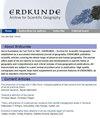Dendrometer measurements of arctic-alpine dwarf shrubs and micro-environmental drivers of plant growth - Dataset from long-term alpine ecosystem research in central Norway
IF 1.1
4区 社会学
Q3 GEOGRAPHY
引用次数: 5
Abstract
Here, we present fine-scale measurements of stem diameter variation from three common arctic-alpine dwarfshrub species monitored in two mountain regions of Central Norway. All three species (Betula nana, Empetrum nigrum ssp. hermaphroditum, and Phyllodoce caerulea) are abundant within the studied regions and highly important contributors to potential future arctic-alpine vegetation shifts. A profound understanding of their radial growth patterns therefore has the potential to yield crucial information regarding climate-growth relations within these ecosystems. We used high-resolution dendrometers (type DRO) to monitor 120 specimens, taking measurements near the shoot base of one major horizontal stem. Along with the shrub growth measurements, we measured on-site micro-environmental data at each studied site, including shoot zone and root zone temperatures as well as soil moisture. All data were recorded at an hourly scale and are presented as daily mean values. The monitoring period spanned five full years (2015 2019), with additional data from 2014 and 2020. Data were collected within one of the most continental climate regions of Europe, the Vågå/Innlandet region, and in the oceanic climate region Geiranger/Møre og Romsdal, spanning a steep climate gradient over just ~100 km horizontal distance. Both study regions are characterized by steep elevational gradients and highly heterogeneous micro-topography. The studied sites were chosen to represent these natural conditions using the transect principle. The collection of our original data is subject of our long-term alpine ecosystem monitoring program since 1991, from which numerous publications function as the basis for a recent project on the use of dendrometer data in alpine ecosystem studies.北极高山矮灌木的树木密度计测量和植物生长的微观环境驱动因素——来自挪威中部长期高山生态系统研究的数据集
在这里,我们对挪威中部两个山区监测到的三种常见的北极高山矮灌木的茎径变化进行了精细测量。所有三个物种(桦树、黑Empetrum nigrum ssp.雌雄同体和蓝叶Phyllodoce caerulea)在研究区域内都很丰富,对未来北极高山植被的潜在变化起着非常重要的作用。因此,深入了解它们的径向增长模式,有可能获得有关这些生态系统内气候增长关系的重要信息。我们使用高分辨率树木测量仪(DRO型)监测了120个标本,在一个主要水平茎的茎基附近进行了测量。除了灌木生长测量外,我们还测量了每个研究地点的现场微观环境数据,包括地上部和根部的温度以及土壤湿度。所有数据以小时为单位进行记录,并以日平均值表示。监测期为五年(2015年至2019年),2014年和2020年的额外数据。数据是在欧洲大陆性最强的气候区之一,Vågå/Insladet区和海洋性气候区Geiranger/Møre og Romsdal收集的,跨越了约100公里的陡峭气候梯度。这两个研究区域都具有陡峭的海拔梯度和高度不均匀的微观地形。选择研究地点是为了利用样带原理来代表这些自然条件。自1991年以来,我们的原始数据收集一直是长期高山生态系统监测计划的主题,其中许多出版物是最近一个关于在高山生态系统研究中使用树木测量仪数据的项目的基础。
本文章由计算机程序翻译,如有差异,请以英文原文为准。
求助全文
约1分钟内获得全文
求助全文
来源期刊

Erdkunde
地学-自然地理
CiteScore
2.00
自引率
7.10%
发文量
17
审稿时长
>12 weeks
期刊介绍:
Since foundation by Carl Troll in 1947, ''ERDKUNDE – Archive for Scientific Geography'' has established as a successful international journal of geography. ERDKUNDE publishes scientific articles covering the whole range of physical and human geography. The journal offers state of the art reports on recent trends and developments in specific fields of geography and comprehensive and critical reviews of new geographical publications. All manuscripts are subject to a peer-review procedure prior to publication. High quality cartography and regular large sized supplements are prominent features of ERDKUNDE, as well as standard coloured figures.
 求助内容:
求助内容: 应助结果提醒方式:
应助结果提醒方式:


